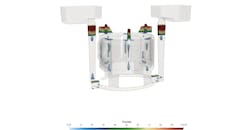New Update to CFD-based Simulation
FLOW SCIENCE INC. released a new update to its computational fluid dynamics-based (CFD) simulation platform. In addition to its improvements to its well-established metalcasting simulation platform – FLOW-3D CAST – FLOW-3D 2025R1 introduces FLOW-3D AM for laser-based additive manufacturing simulation, and FLOW-3D WELD for precision welding simulation. The FLOW-3D 2025R1 release includes several significant additions to FLOW-3D CFD simulation capabilities, which bring powerful functionality, full HPC support, and increased ease of use to all FLOW-3D users.
“With the integration of FLOW-3D AM and FLOW-3D WELD into the FLOW-3D product family, we’re putting advanced manufacturing simulation tools into the hands of practicing engineers,” stated Flow Science president John Wendelbo. “These are highly accessible but also extremely accurate solutions. And with scalability and automation capabilities, you have something truly state-of-the-art.”
FLOW-3D AM 2025R1 brings a new, fully integrated simulation platform for processes like powder bed fusion and directed energy deposition. FLOW-3D AM introduces a unified user interface and pre-loaded process templates that simplify complex simulation setup. And users can easily move between steps in their process simulations while maintaining complete project continuity.
Drawing from the core FLOW-3D solver, FLOW-3D AM 2025R1 offers support for high performance computing (HPC) platforms, accelerating simulating throughput. Additive manufacturing simulations on HPC platforms are now up to ~9x faster as compared to standard workstation configurations.
FLOW-3D WELD 2025R1 introduces improved workflows for precision welding simulation with a unified user interface, simulation templates, new process automation and analysis capabilities, and significant performance improvements.
FLOW-3D 2025R1 enhances particle modeling with a new discrete element method (DEM) model. This release extends particle-particle interaction capabilities for use cases such as granular material handling, slurry mixing, and particle-laden flows. HPC support reduces simulation runtimes, enabling rapid product development and process optimization.
For metalcasting, FLOW-3D CAST 2025R1 includes improvements to the solidification and shrinkage, shot sleeve, and valve models. An improved solidification and shrinkage model with revised porosity outputs in the new EXODUS format allows users to simplify the analysis and interpretation of porosity.
An enhanced valve model allows users to more accurately predict the final location of defects by specifying a target volume of metal allowed to exit valves and vents.
In the FLOW-3D CAST high-pressure diecasting (HPDC) workspace, users can now capture the movement of solidified metal in the shot sleeve with the porosity-based solidification model, providing a much more accurate thermal profile during fill.
FLOW-3D HYDRO 2025R1 introduces a new discrete element method (DEM) model, so users may account for particle-particle interactions such as collision and friction, providing utility beyond that of the standard Lagrangian particle model. The new DEM model provides insights into the stability of rocks or rip-rap in different flow conditions, opening exciting possibilities for cost savings and risk reduction for unique protection systems on riverbanks and other structures. The model can also help users gain insights into grit separation systems, stormwater separators, and other granular flow scenarios where small objects interact with each other.
Learn more at www.flow3d.com.
